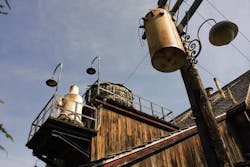Whether Water or Wastewater, Communication is Key
About the author:
Courtney McVay, P.E., is project manager with H.R. Gray. McVay can be reached at [email protected].
Every construction project at a treatment plant is unique, just as every treatment facility is unique. Although the processes are similar at wastewater and water plants, each plant type has its own mission and critical treatment areas, which will impact how plant staff reacts and responds to construction activities. Most young engineers and project managers will receive a crash course in this lesson when transitioning between wastewater and drinking water projects and facilities. Depending on the plant manager, the experience of the treatment staff and how many construction activities have taken place at the facility, a project manager will find differences. These mostly revolve around communication that will significantly influence how each project should be approached.
I began my career as a field engineer working on wastewater projects where I mainly focused on big-picture elements, such as the schedule, delays and budget. At one facility, plant personnel were not typically involved at the project level. The owner was accustomed to large-scale construction projects and trusted the consultants to manage the daily work and keep the plant informed of progress and activities that could impact operations.
The first time I managed a drinking water project, I quickly realized the importance of maintaining a heightened level of coordination with plant management. Due to the critical nature of providing clean and safe drinking water to the community, the plant staff wanted significant involvement in all areas that impacted operations. The priorities for water projects include safety—there are many dangerous chemicals at a water plant—and maintaining water quality and uninterrupted service. Any time an outage cannot be avoided, multiple parties must meet to review and plan prior to that work taking place. The contractor must be flexible during this process.
As another example, I currently am working as a field engineer for a water project in which some work was performed in an underground channel. This required an outage request to be submitted for review, work plans to be laid out stating dewatering times and procedures, disinfection protocols to be submitted and numerous meetings to discuss the plan of action. Due to the requirements of the disinfection procedure, the contractor had to visit the site on a weekend and take samples to confirm all Safe Drinking Water Act and water quality standards were met. Throughout the process, there was an emphasis on protecting water quality and safety.
Another key difference between facilities is how submittal reviews are handled. In some cases, plant personnel want to be involved in the review and approval of submittals. As a result, they will know exactly what to expect once the project is complete. While this seems like an advantage, it places greater importance on the timeline and ensures there are no delays. Other facilities rely on the engineer’s specifications and the submittal review to capture specific needs of the owner.
For water projects, my best advice is to overcommunicate. When we receive an outage request, my role is to ensure our field representative reviews the document before sending it to the plant for review. Oftentimes, I follow up with a phone call to verify the document was received. If I haven’t heard from the plant within a couple of days, I will reach out to make sure they understand the request and do not have any questions. Outages are also discussed at our monthly coordination meetings and progress meetings. These meetings are staggered to ensure we are consulting with the plant every other week.
My advice for all project types is to discuss everything at the monthly progress meeting. Since plant personnel attend these meetings, this provides an opportunity to convey what is occurring regarding the project as well as what personnel can anticipate in the future. To keep the project moving, the owner’s construction team also communicates with the contractor daily so issues can be dealt with as they arise. It’s a good idea to add a quick update on those issues and resolutions to the monthly agenda.
Whether water or wastewater, we need to understand our clients and their mission. At the beginning of the project, communicate with all parties involved in the work—i.e., the design professional, owner’s construction team, regulatory agencies and contractor—to better understand their expectations. Become familiar with the different personalities and how they want to be involved. Some project owners like to be notified of every decision, big or small, while others take a “We hired you to take care of these issues” approach. In either case, our job is to help improve their facilities and mission.
Facilitating a heightened level of communication may require some adjustments on your part, but it’s worth it. We are all on the same team with the end goal of providing the best product possible to the owner and its residents.

